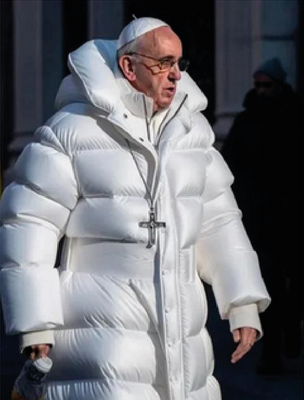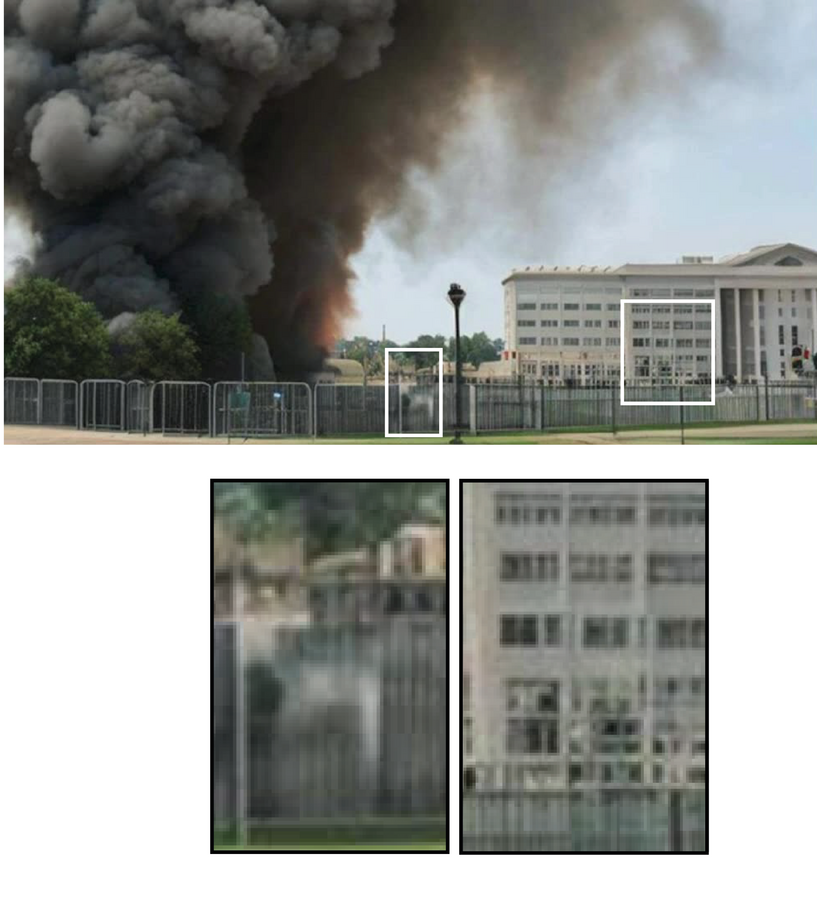mNo edit summary |
No edit summary |
||
| (48 intermediate revisions by 4 users not shown) | |||
| Line 1: | Line 1: | ||
<div class="metadata"> | <div class="metadata"> | ||
== | <span id="Martyna - fuzzy fences, shiny coats, trees on fire"></span> | ||
'''Martyna Marciniak''' | == fuzzy fences, shiny coats, trees on fire == | ||
</div> | '''Martyna Marciniak''' | ||
</div> | |||
[[File:pope.png|thumb|400x400px|center]] | |||
[[File:pentagon.png|thumb|775x775px|center]] | |||
In | In early 2023 an unprecedented number of AI-generated images began appearing on social media, ranging from harmless and entertaining ones, like the image of the Pope wearing Balenciaga, to ones with much higher stakes, like the photo of an ‘explosion at the Pentagon’. | ||
While the uncanniness of the pope wearing Balenciaga produced a sensory reaction, immediately awakening attention to the high likelihood of its fakeness, the ‘Pentagon event’ didn’t. The image got shared and reposted, sparking panic and causing stocks to plummet. Once the image was confirmed fake, endless articles and essays focusing on the dangers of AI-generated images began appearing online. However, it was not the image itself, but the context of the claim attached to it that drew the attention of twitter users. Arguably the documentary visual is there not to inform, but to help generate a state of panic (Steyerl, 2015). | |||
One of the reasons for this absence of uncanny feeling when interacting with the 'Pentagon fake' is perhaps the repetitive and passive interactions with the images of catastrophic and extraordinary events in traditional and social media, of ''eyes that see too much -- and register nothing'' (Buck-Morss, 1992). The panic overtakes the senses, resulting in a lack of an acute uncanny sensation in response to images of catastrophes (real and faux), which makes the truth more vulnerable. | |||
I would like to propose a different reading of this ‘AI event’ -- away from the techno-doom and towards a definition of new aesthetics of digital facts. In the process, I would like to highlight the role of the modes of perceiving, investigative gestures and notations as important aspects of collective ''sensing and sense-making'' (Fuller and Weizman, 2021). | |||
The object of the controversy (the explosion) is impossible to disprove or confirm based on the image alone. Instead, further analysis of the materiality of the image, the reality it portrays, and the interactions of the image as an online artefact need to be considered. | |||
Upon investigating the images online through reverse image searching, logging of the duplicates, comparing and collaging the original with confirmed photos of the Pentagon, most of the analyses published on twitter, focused on the glitches within the image. The researchers zoomed into high-detail fragments and outlined the boundaries of the impossible geometries they perceived (the phantasmagorias of the bending fence with its fuzzy borders, the delirious architecture of the facade of the supposed Pentagon building) with brightly coloured rectangles -- a visual record of the researcher ''organising the perceptual field'' (Goodwin, 1994). | |||
Having the attention drawn to the framed uncanny artefacts within the original image [-->] allows one to notice the incoherent reality portrayed in the whole image: the agency and circumstance of the camera that took the photo, the strangely ordered frontal framing, the lack of movement in what one would only expect to be a chaotic scene. This detached, disembodied and neutral perspective and composition could be considered yet another way of echoing AI’s persistent erasure of bias (Steyerl, 2023). | |||
[[ | To regain agency beyond relying on authorities of truth or resigning the trust in our ability to perceive, we can seek out a network of connections and gestures that extend from the material analysis and investigate the realities of the source image. This way we can enable a new aesthetics of fact characterised by collective sense-making, akin to a spider casting its web as an extension of its sensory field. | ||
[[File:collage.png|thumb|900x900px|center]] | |||
<noinclude> | |||
[[Category:Content form]] | |||
</noinclude> | |||
Latest revision as of 11:19, 7 February 2024


In early 2023 an unprecedented number of AI-generated images began appearing on social media, ranging from harmless and entertaining ones, like the image of the Pope wearing Balenciaga, to ones with much higher stakes, like the photo of an ‘explosion at the Pentagon’.
While the uncanniness of the pope wearing Balenciaga produced a sensory reaction, immediately awakening attention to the high likelihood of its fakeness, the ‘Pentagon event’ didn’t. The image got shared and reposted, sparking panic and causing stocks to plummet. Once the image was confirmed fake, endless articles and essays focusing on the dangers of AI-generated images began appearing online. However, it was not the image itself, but the context of the claim attached to it that drew the attention of twitter users. Arguably the documentary visual is there not to inform, but to help generate a state of panic (Steyerl, 2015).
One of the reasons for this absence of uncanny feeling when interacting with the 'Pentagon fake' is perhaps the repetitive and passive interactions with the images of catastrophic and extraordinary events in traditional and social media, of eyes that see too much -- and register nothing (Buck-Morss, 1992). The panic overtakes the senses, resulting in a lack of an acute uncanny sensation in response to images of catastrophes (real and faux), which makes the truth more vulnerable.
I would like to propose a different reading of this ‘AI event’ -- away from the techno-doom and towards a definition of new aesthetics of digital facts. In the process, I would like to highlight the role of the modes of perceiving, investigative gestures and notations as important aspects of collective sensing and sense-making (Fuller and Weizman, 2021).
The object of the controversy (the explosion) is impossible to disprove or confirm based on the image alone. Instead, further analysis of the materiality of the image, the reality it portrays, and the interactions of the image as an online artefact need to be considered.
Upon investigating the images online through reverse image searching, logging of the duplicates, comparing and collaging the original with confirmed photos of the Pentagon, most of the analyses published on twitter, focused on the glitches within the image. The researchers zoomed into high-detail fragments and outlined the boundaries of the impossible geometries they perceived (the phantasmagorias of the bending fence with its fuzzy borders, the delirious architecture of the facade of the supposed Pentagon building) with brightly coloured rectangles -- a visual record of the researcher organising the perceptual field (Goodwin, 1994).
Having the attention drawn to the framed uncanny artefacts within the original image [-->] allows one to notice the incoherent reality portrayed in the whole image: the agency and circumstance of the camera that took the photo, the strangely ordered frontal framing, the lack of movement in what one would only expect to be a chaotic scene. This detached, disembodied and neutral perspective and composition could be considered yet another way of echoing AI’s persistent erasure of bias (Steyerl, 2023).
To regain agency beyond relying on authorities of truth or resigning the trust in our ability to perceive, we can seek out a network of connections and gestures that extend from the material analysis and investigate the realities of the source image. This way we can enable a new aesthetics of fact characterised by collective sense-making, akin to a spider casting its web as an extension of its sensory field.
